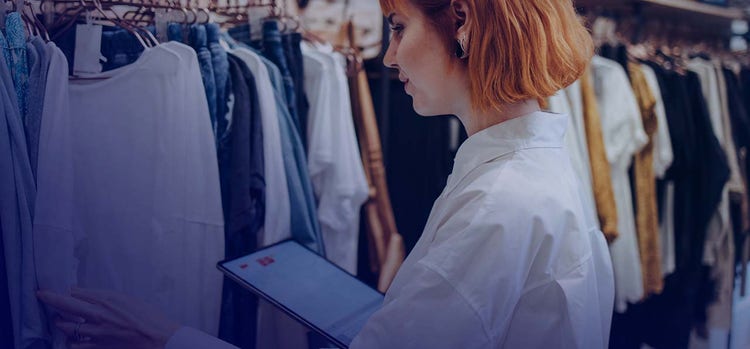
Sustainability demands: 6 keys for retail and consumer goods
data-xy-axis-lg:0% 0%; data-xy-axis-md:null; data-xy-axis-sm:50% 0%
<p><br> May 08, 2023</p>
Sustainability demands: 6 keys for retail and consumer goods
<p><b>Technology is critical in addressing the sustainability value chain.</b></p>
<p>Where sustainability is concerned, retail and consumer goods companies are scrambling. They find themselves in a mad dash to address the lack of transparency and traceability that plagues their supply chain systems. This stampede has many causes. One is the need to deliver on increasing expectations around social responsibility and human rights; another is the need to address issues such as biodiversity and deforestation in their supply chain; the list goes on. Today and for the foreseeable future, these issues will be critical in elevating brand reputation.</p> <p>Myriad factors come to bear when retail and consumer goods companies embark on the sustainability journey. These complex and interrelated challenges include quantifying environmental impact, addressing resource depletion, and reducing waste generation.</p> <p>To make environmentally, socially <i>and </i>financially sustainable change, businesses must address these challenges across the entire value chain, focusing on supply chain management, resource efficiency, sustainable design, carbon footprint, sustainable logistics, and product transparency and traceability.</p> <p>Naturally, technology is a key tool in enabling companies to enhance their supply chain sustainability. In our conversations with global leaders in retail and consumer goods, the pain points listed below have repeatedly surfaced—and for all of these, technology can catalyze solutions that meet both sustainability and financial objectives.</p> <ol> <li><b>Limited traceability upstream and downstream.</b> Blockchain and artificial intelligence (AI) technology can be used to create a transparent and immutable record of the origin, movement and ownership of goods throughout the supply chain. This helps companies ensure that products are sourced sustainably, and that labor and human rights standards are met. Businesses can implement a traceability system in which each product is assigned a unique digital ID containing information about the product's origin, quality and compliance with sustainability standards. This information is then recorded on a blockchain, which allows for transparency and immutability of data, enabling companies and consumers to verify the information and track the product throughout its lifecycle.<br> <br> Leading companies, such as Walmart and Nestle have used blockchain technology to increase visibility and traceability of their supply chain. Walmart, for example, has implemented a traceability system using blockchain for pork in China and mangoes in the United States. This allows the retailer to trace the origin of those products, ensuring they meet food safety standards and are sustainably sourced. Nestle, for its part, has used blockchain to track milk from farms to factories in New Zealand, providing transparency and traceability of the milk supply chain.<br> <br> </li> <li><b>Lack of supplier emissions data.</b> Companies can use software and data analytics to identify and rank their high-impact suppliers—those that use impact-heavy materials in their products or services (i.e., rare metals, water, etc.), large transport distances, high sales numbers, etc. They can also use various analytical tools and software to obtain data from their suppliers on their environmental and social activities. This can range from low-tech solutions such as sending out a sustainability assessment to more high-tech solutions such as a sustainability-focused internal supplier portal or direct access to a supplier’s emissions data within their tech ecosystem. This gives businesses the data to evaluate and compare the carbon footprint, resource use and labor practices of their suppliers—and to identify opportunities for improvement.<br> <br> Unilever and Patagonia have used software and data analytics in this manner. Unilever uses a tool along with its Sustainable Agriculture Code to assess the sustainability of its agricultural suppliers. Patagonia has implemented a Supply Chain Environmental Responsibility Program at supplier facilities worldwide and uses industry-wide tools such as the Higg Index to assess the environmental impact of its products and materials, allowing the company to identify areas in which improvement is needed.<br> <br> </li> <li><b>Incomplete sourcing information.</b> Technology makes it possible to track the environmental impact of the extraction, production and transportation of raw materials. It also enables companies to identify, prioritize and source sustainable materials, such as organic versus conventional cotton, and track the movement and usage of these materials throughout the supply chain. Existing software solutions can help identify which materials are more sustainable and can facilitate scenario analyses on a variety of factors to determine trade-offs between more and less sustainable materials, material availability, and other criteria to enable businesses to make sustainability-positive sourcing decisions.<br> <br> For example, Adidas uses a digital tool called TrusTrace that helps it track the environmental impact of different materials and prioritize which materials to use in its products.<br> <br> </li> <li><b>Uncertain product demand.</b> Another potential use of data analytics is to predict product demand, allowing retailers and consumer goods companies to optimize inventory and reduce waste. Predictive analytics involves using data from historical sales, weather, and past purchases along with inventory levels, product movement and other external factors to predict future demand for products. This can enable companies to optimize inventory levels, avoid stockouts, and reduce overproduction and waste.<br> <br> Retail and consumer goods companies such as Amazon and Zara use data analytics to predict demand for products, allowing them to optimize inventory and reduce waste. For example, Amazon uses predictive analytics to anticipate demand and adjust inventory levels in its warehouses. Zara uses data analytics to predict fashion trends and adjust production accordingly.<br> <br> </li> <li><b>Lagging logistics.</b> GPS tracking, Internet of Things (IoT) devices, and route optimization software can enable companies to move from manual, reactive planning and tracking of transportation routes and modes to optimized smart logistics and transportation, reducing emissions and the environmental impact of the movement of goods. For example, fleet management software can enable asset tracking, reduce idling time, optimize fuel use and decrease the number of empty miles driven, allowing businesses to reduce their carbon footprint and improve logistics efficiency. This can also help mitigate increasing freight prices that many companies are facing.<br> <br> Logistics companies that retailers and consumer goods companies rely on, such as DHL and UPS, use technology in this way. DHL’s Green Fleet Management system optimizes its fleet and reduces emissions. UPS uses route optimization software and real-time tracking to minimize transportation costs and emissions.<br> <br> </li> <li><b>Reactive supply chain.</b> Companies can move toward a digital supply chain enabled by technologies such as blockchain, Big Data, cloud computing, machine learning, IoT, and AI to streamline and monitor conditions in the supply chain and respond proactively to disruptions or changes in demand or supply. For example, data from inventory and sales systems can be used to identify trends and respond to changes in demand as well as to monitor and manage other issues including resource shortages, defective materials, missing inventory and poor quality. This can assist companies and their suppliers in collaborating and being proactive, while reducing impact on the environment—for example, reducing waste via optimized inventory and lowering energy and emissions via improved logistics efficiency.<br> <br> Retail and consumer goods companies such as Walmart and Target have used real-time data and analytics to monitor conditions in the supply chain and respond quickly to disruptions or changes in demand. Walmart, for example, uses real-time data to monitor inventory levels and anticipate changes in demand. Target, for its part, uses data analytics to monitor weather conditions and anticipate disruptions to logistics.</li> </ol> <p>The retail and consumer goods industries face numerous challenges in their efforts to achieve sustainability and environmental, social and governance goals. The increasing demand for more sustainable, socially responsible practices will continue to come from investors, consumers, and legislators. Failure to meet these expectations could have a devasting impact not only on businesses, but on society at large.</p> <p>While advances in technology will continue to enable organizations to make progress, they must remain steadfast and double down on their commitment to adopting these solutions. With a commitment to collaboration, innovation and transparency, the retail and consumer goods industries can drive positive change and create a more sustainable future for all. And that’s just good business.</p> <p><i>To learn more, visit the </i><a href="https://www.cognizant.com/us/en/services/sustainability-services" target="_blank"><i>Sustainability Services</i></a><i> section of our website or </i><a href="https://www.cognizant.com/us/en/about-cognizant/contact-us" target="_blank"><i>contact us</i></a><i>.<br> <br> This article was written by Anca Novacovici Lunn, Senior Principal Sustainability Advisor in Cognizant’s North America Sustainability Practice.</i></p>
<p>We’re here to offer you practical and unique solutions to today’s most pressing technology challenges. Across industries and markets, get inspired today for success tomorrow.</p>
